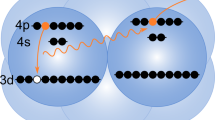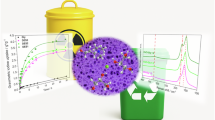Abstract
THE absorption spectrum of iodine monochloride consists of a group of bands (group Cl) with an upper convergence limit at about 17430 cm.-1 corresponding to the dissociation of ICl into a normal iodine atom and a chlorine atom in the 22P1 state. There is also another group (group I) of which only two members (17446 cm.-1 and 17570 cm.-1) were observed by Gibson and Ramsperger. Several further members of this group have since been observed (Gibson: unpublished measurements). These are visible in the region between the convergence and the absorption maximum of the continuum of group Cl.
This is a preview of subscription content, access via your institution
Access options
Subscribe to this journal
Receive 51 print issues and online access
$199.00 per year
only $3.90 per issue
Buy this article
- Purchase on SpringerLink
- Instant access to full article PDF
Prices may be subject to local taxes which are calculated during checkout
Similar content being viewed by others
Author information
Authors and Affiliations
Rights and permissions
About this article
Cite this article
GIBSON, G., RICE, O. Diffuse Bands and Predissociation of Iodine Monochloride. Nature 123, 347–348 (1929). https://doi.org/10.1038/123347b0
Issue date:
DOI: https://doi.org/10.1038/123347b0
This article is cited by
-
The Photo-Reaction of Hydrogen and Iodine Monochloride
Nature (1931)



